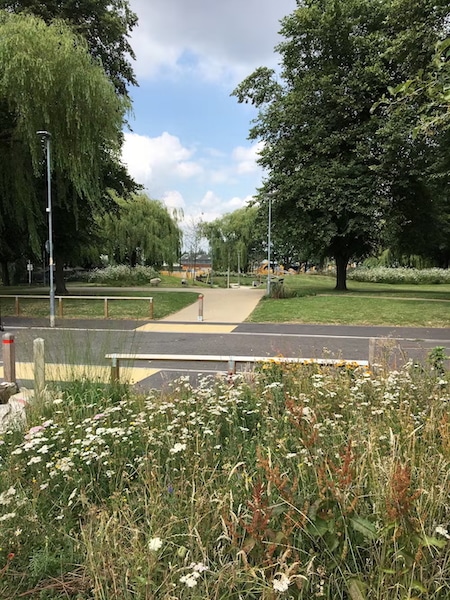This post was originally published on Eco Watch
New research detailed in The Conversation provides five ways cities can better cope with and become more resilient to climate change through progressive climate adaptation.
The world’s societies, economies and ecosystems are under imminent threat from climate breakdown. But, due to what the United Nations has termed an “adaptation gap,” many countries and cities are perpetually unprepared, reported The Conversation.
“Building climate resilience is notoriously difficult. Economic barriers limit investment in infrastructure and technology. Social inequities undermine the capacity of vulnerable populations to adapt. And inconsistent policies impede coordinated efforts across sectors and at scale,” Paul O’Hare, a lecturer in human geography and urban development at England’s Manchester Metropolitan University, wrote in The Conversation.
O’Hare identified five ways cities can more effectively and progressively adapt and become more resilient to climate change.
The first is to not just “bounce back” following a crisis.
O’Hare said that when natural disasters like storms, floods and wildfires hit, governments often make rebuilding as quickly as possible the priority.
“Though understandable, resilience doesn’t just entail coping with the effects of climate change. Instead of ‘bouncing back’ to a pre-shock status, those in charge of responding need to encourage ‘bouncing forward,’ creating places that are at less risk in the first place,” O’Hare said.
Swales and sustainable urban drainage in Gorton climate-resilient park, Manchester, UK. Paul O’Hare, CC BY-NC-ND
The second resilience and adaptation strategy O’Hare recommended is to be “informed by risk.”
“It can be difficult to predict what the consequences of a crisis might be. Cities are complex, interconnected places. Transboundary risks – the consequences that ripple across a place – must be taken into account,” O’Hare wrote. “The best climate adaptation plans recognise that vulnerability varies across places, contexts and over time. The most effective are holistic: tailored to specific locations and every aspect of society.”
O’Hare said both climatic and non-climatic risk features must be considered in assessments.
“Many existing assessments have limited scope. But others do acknowledge how ageing infrastructures and pressures to develop land to accommodate ever intensifying urban populations exacerbate urban flood risk. Others too, such as the recently published Cambridge climate risk plan, detail how climate risk intersects with the range of services provided by local government,” O’Hare explained.
O’Hare said “systems thinking,” which looks at problems as part of larger, interconnected systems, can be used to identify mutually-dependent drivers of change.
“Good risk assessments will, for example, take note of demographics, age profiles and the socio-economic circumstances of neighbourhoods, enabling targeted support for particularly vulnerable communities. This can help ensure communities and systems adapt to evolving challenges as climate change intensifies, and as society evolves over time,” O’Hare said.
The third strategy is “transformative action.”
“There is no such thing as a natural disaster. The effects of disasters including floods and earthquakes are influenced by pre-existing, often chronic, social and economic conditions such as poverty or poor housing,” O’Hare said.
O’Hare explained that progressive climate resilience looks past immediate shocks to the underlying causes of inequality and vulnerability.
“This ensures that society is not only better prepared to withstand adverse events in the future, but thrives in the face of uncertainty,” O’Hare said.
The fourth recommendation by O’Hare is to use “collective approaches.”
“Effective climate resilience demands collective action. Sometimes referred to as a ‘whole of society’ response, this entails collaboration and shared responsibility to address the multifaceted challenges posed by a changing climate,” O’Hare wrote in The Conversation.
O’Hare said the most successful initiatives consider more broad and longer-term risks while avoiding self-protection of cities, buildings and people.
“For instance, developments not at significant risk should still incorporate adaptation measures including rainwater harvesting or enhanced greening to lower a city’s climate risk profile and benefit local communities, neighbouring authorities and surrounding regions,” O’Hare wrote. “So, progressive resilience is connected, comprehensive and inclusive. Solidarity is key, leveraging resources to address common challenges and fostering a sense of shared purpose and mutual support.”

The last strategy — which O’Hare says is the most effective — is to exploit co-benefits to leverage additional sector and policy benefits that reduce vulnerability to shocks while at the same time addressing other environmental and social challenges.
The United Nations refers to these as “multiple resilience dividends.”
“In northern Europe, for example, moorlands can be restored to retain water helping alleviate downstream flooding, but also to capture carbon and provide vital habitats for biodiversity,” O’Hare wrote. “In south-East Asia solar panels installed on reservoirs generate renewable energy to reduce greenhouse gas emissions, while providing shade to reduce evaporation and conserve water resources during droughts.”
O’Hare pointed out that, while adaptation is critical to tackling climate change worldwide, “the real challenge is to deal with the impacts of climate change while simultaneously creating communities that are fairer, healthier, and better equipped to face any manner of future risks.”
The findings of the study, “Not ‘just’ climate adaptation — towards progressive urban resilience,” were published in the journal Humanities and Social Sciences Communications.
“Climate breakdown poses immense — potentially existential — threats to global economies, societies, and ecosystems. Mitigation must be pursued with vigour. However, given the consensus regarding the inevitability of climate change, and the doom-laden predictions of its impacts, adaptation is urgent,” O’Hare wrote in the study.
The post 5 Ways Cities Can Become More Resilient to Climate Change: Study appeared first on EcoWatch.





0 Comments